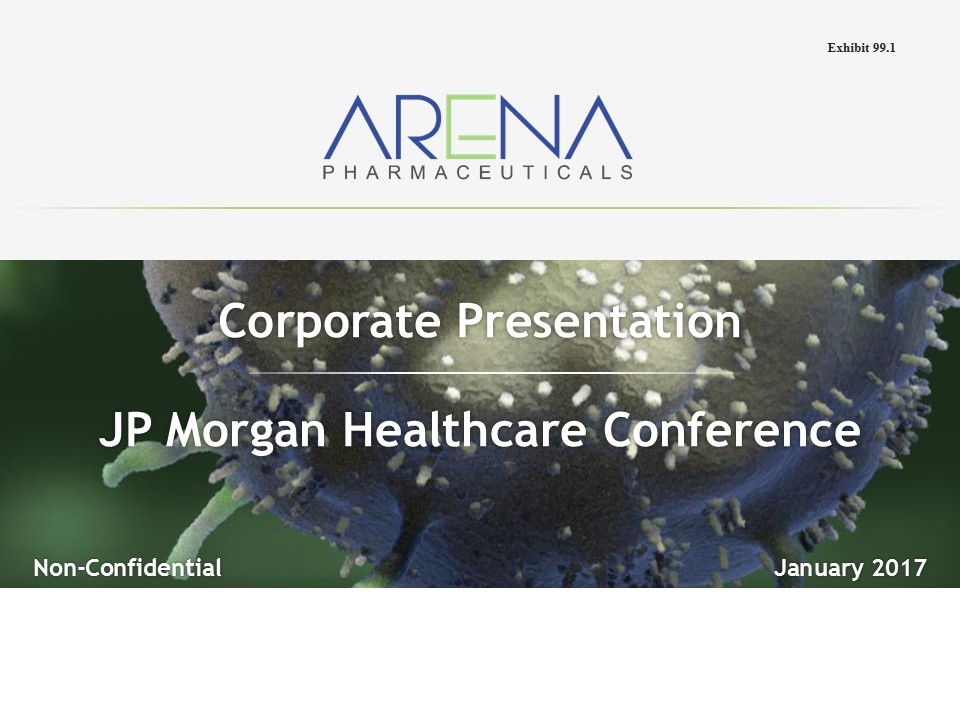
Non-Confidential January 2017 Corporate Presentation JP Morgan Healthcare Conference Exhibit 99.1
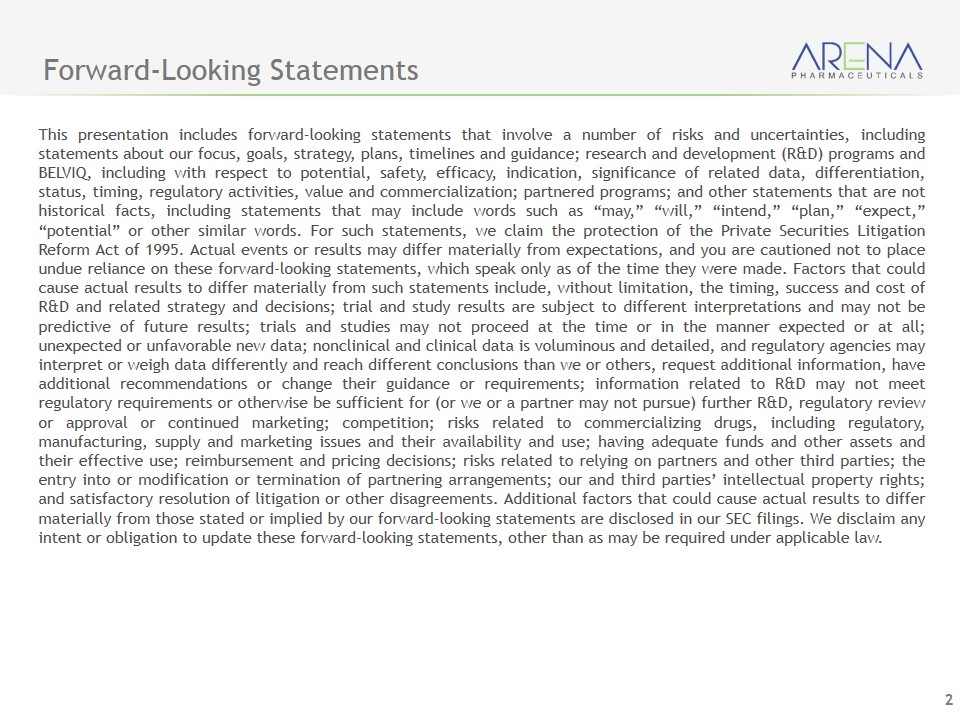
Forward-Looking Statements This presentation includes forward-looking statements that involve a number of risks and uncertainties, including statements about our focus, goals, strategy, plans, timelines and guidance; research and development (R&D) programs and BELVIQ, including with respect to potential, safety, efficacy, indication, significance of related data, differentiation, status, timing, regulatory activities, value and commercialization; partnered programs; and other statements that are not historical facts, including statements that may include words such as “may,” “will,” “intend,” “plan,” “expect,” “potential” or other similar words. For such statements, we claim the protection of the Private Securities Litigation Reform Act of 1995. Actual events or results may differ materially from expectations, and you are cautioned not to place undue reliance on these forward-looking statements, which speak only as of the time they were made. Factors that could cause actual results to differ materially from such statements include, without limitation, the timing, success and cost of R&D and related strategy and decisions; trial and study results are subject to different interpretations and may not be predictive of future results; trials and studies may not proceed at the time or in the manner expected or at all; unexpected or unfavorable new data; nonclinical and clinical data is voluminous and detailed, and regulatory agencies may interpret or weigh data differently and reach different conclusions than we or others, request additional information, have additional recommendations or change their guidance or requirements; information related to R&D may not meet regulatory requirements or otherwise be sufficient for (or we or a partner may not pursue) further R&D, regulatory review or approval or continued marketing; competition; risks related to commercializing drugs, including regulatory, manufacturing, supply and marketing issues and their availability and use; having adequate funds and other assets and their effective use; reimbursement and pricing decisions; risks related to relying on partners and other third parties; the entry into or modification or termination of partnering arrangements; our and third parties’ intellectual property rights; and satisfactory resolution of litigation or other disagreements. Additional factors that could cause actual results to differ materially from those stated or implied by our forward-looking statements are disclosed in our SEC filings. We disclaim any intent or obligation to update these forward-looking statements, other than as may be required under applicable law.
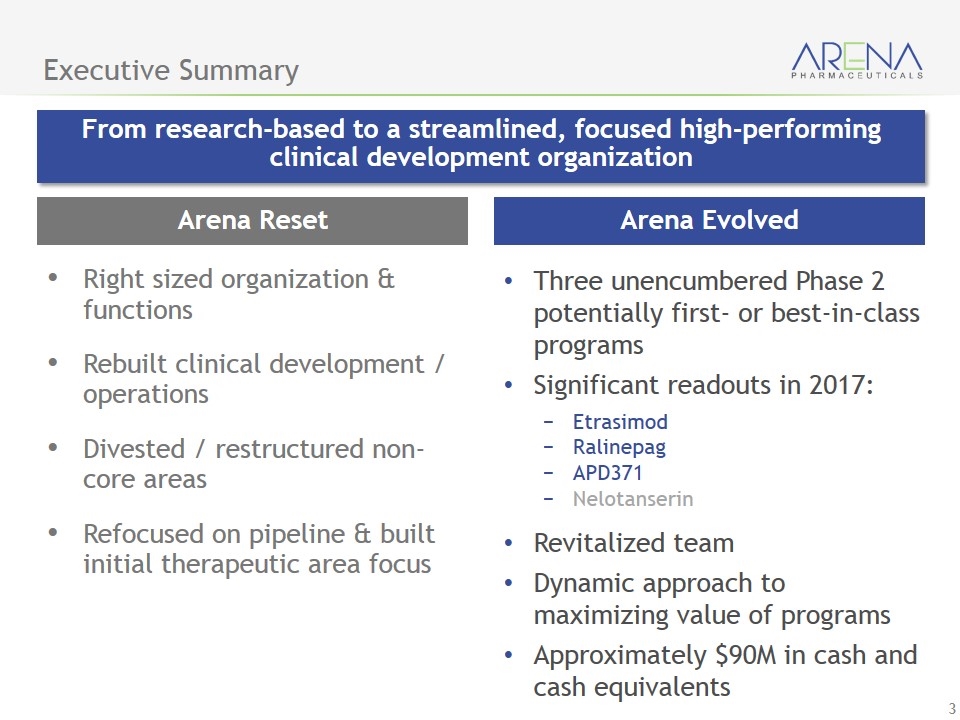
Arena Evolved Executive Summary From research-based to a streamlined, focused high-performing clinical development organization Three unencumbered Phase 2 potentially first- or best-in-class programs Significant readouts in 2017: Etrasimod Ralinepag APD371 Nelotanserin Revitalized team Dynamic approach to maximizing value of programs Approximately $90M in cash and cash equivalents Arena Reset Right sized organization & functions Rebuilt clinical development / operations Divested / restructured non-core areas Refocused on pipeline & built initial therapeutic area focus
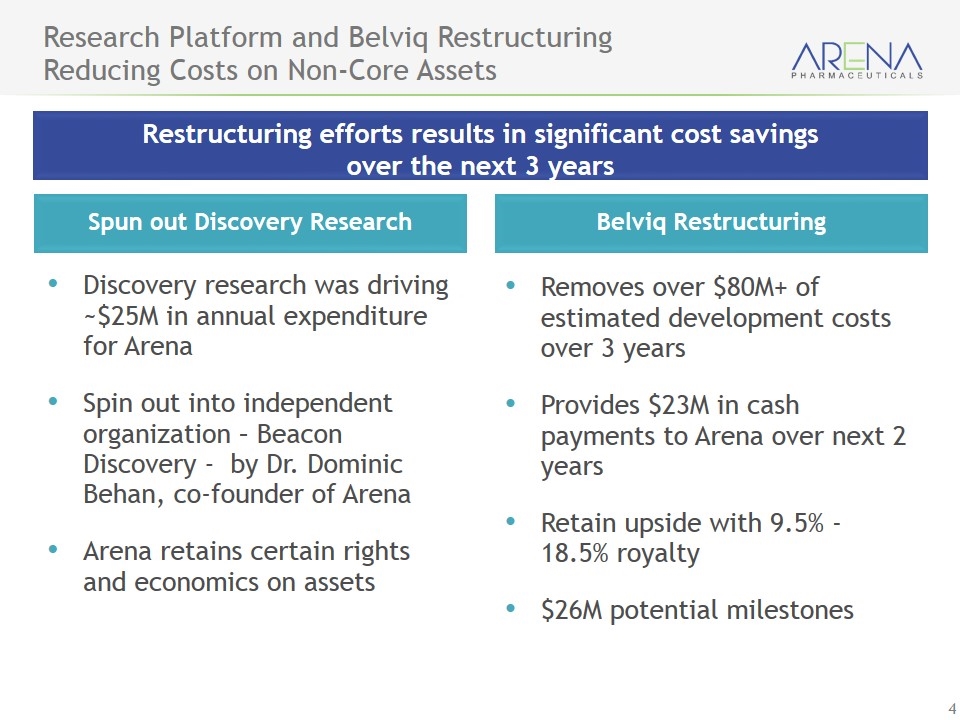
Research Platform and Belviq Restructuring Reducing Costs on Non-Core Assets Discovery research was driving ~$25M in annual expenditure for Arena Spin out into independent organization – Beacon Discovery - by Dr. Dominic Behan, co-founder of Arena Arena retains certain rights and economics on assets Spun out Discovery Research Removes over $80M+ of estimated development costs over 3 years Provides $23M in cash payments to Arena over next 2 years Retain upside with 9.5% - 18.5% royalty $26M potential milestones Belviq Restructuring Restructuring efforts results in significant cost savings over the next 3 years
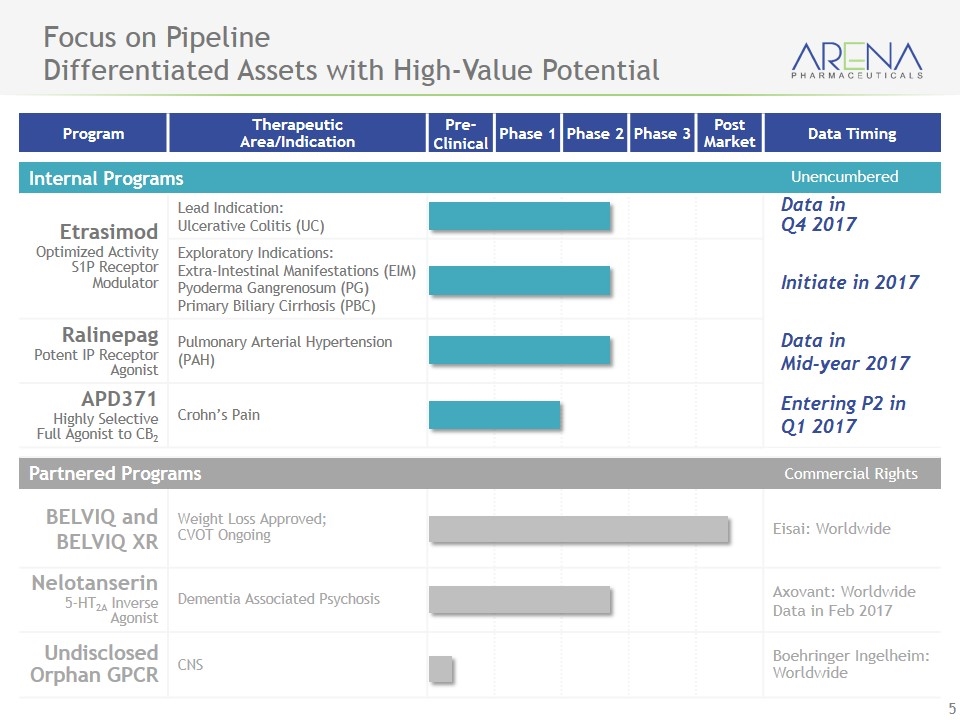
Program Therapeutic Area/Indication Pre- Clinical Phase 1 Phase 2 Phase 3 Post Market Data Timing Internal Programs Etrasimod Optimized Activity S1P Receptor Modulator Lead Indication: Ulcerative Colitis (UC) Exploratory Indications: Extra-Intestinal Manifestations (EIM) Pyoderma Gangrenosum (PG) Primary Biliary Cirrhosis (PBC) Ralinepag Potent IP Receptor Agonist Pulmonary Arterial Hypertension (PAH) APD371 Highly Selective Full Agonist to CB2 Crohn’s Pain Partnered Programs BELVIQ and BELVIQ XR Weight Loss Approved; CVOT Ongoing Eisai: Worldwide Nelotanserin 5-HT2A Inverse Agonist Dementia Associated Psychosis Axovant: Worldwide Data in Feb 2017 Undisclosed Orphan GPCR CNS Boehringer Ingelheim: Worldwide Focus on Pipeline Differentiated Assets with High-Value Potential Commercial Rights Data in Q4 2017 Initiate in 2017 Data in Mid-year 2017 Entering P2 in Q1 2017 Unencumbered

Clinical Development Focus and Externally-Driven Thinking Supported by Revamped Operational Team Amit Munshi, President and CEO CEO, Epirus and Percivia (sold to JNJ) Founder, CBO, Kythera (sold to Allergan) Kevin Lind, Chief Financial Officer TSSP / TPG Pharma Partners Lehman Brothers Cheryl Lassen BSc., MBBCh, VP, Clinical Development Senior development roles at Novartis, BMS, Abbott and Pharmacia / Pfizer Vincent Aurentz, Chief Business Officer President, HemoShear Therapeutics EVP, R&D, Portfolio and Corporate Development Merck Serono Anna Crivici, PhD, VP, Program Management VP Program Management, NantkWest, Amylin Global Project Leader, Pfizer Maurice Mezzino, SVP Corporate Development Business Development executive at BMS, Biogen Idec, BeiGene Chartered Financial Analyst (CFA) Steven Spector, General Counsel Partner Morgan Lewis Board member, Association of Corporate Counsel
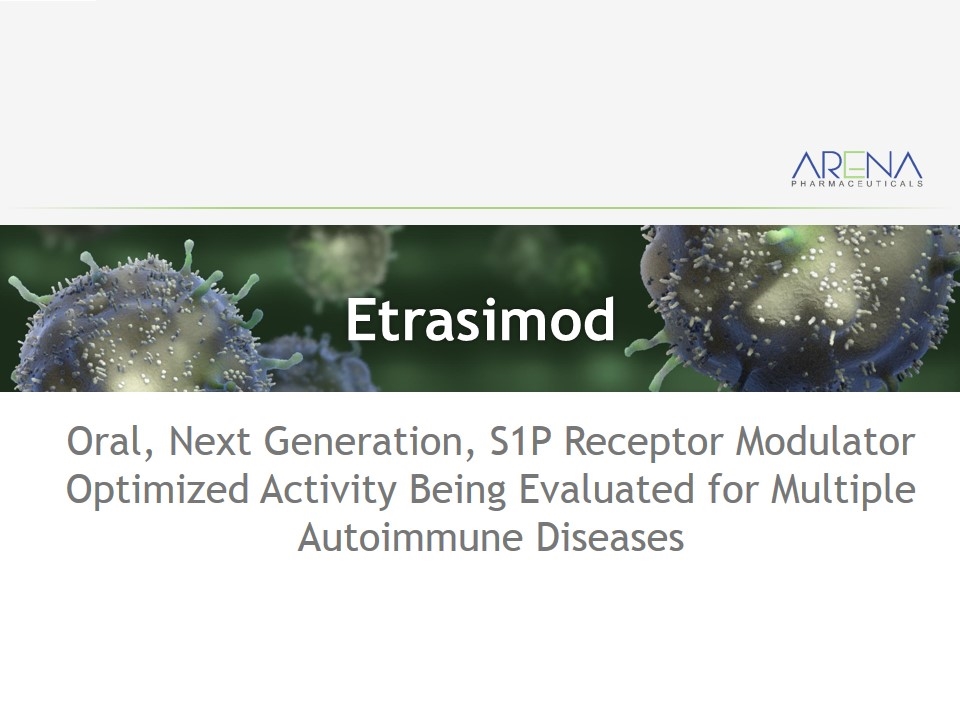
Oral, Next Generation, S1P Receptor Modulator Optimized Activity Being Evaluated for Multiple Autoimmune Diseases Etrasimod
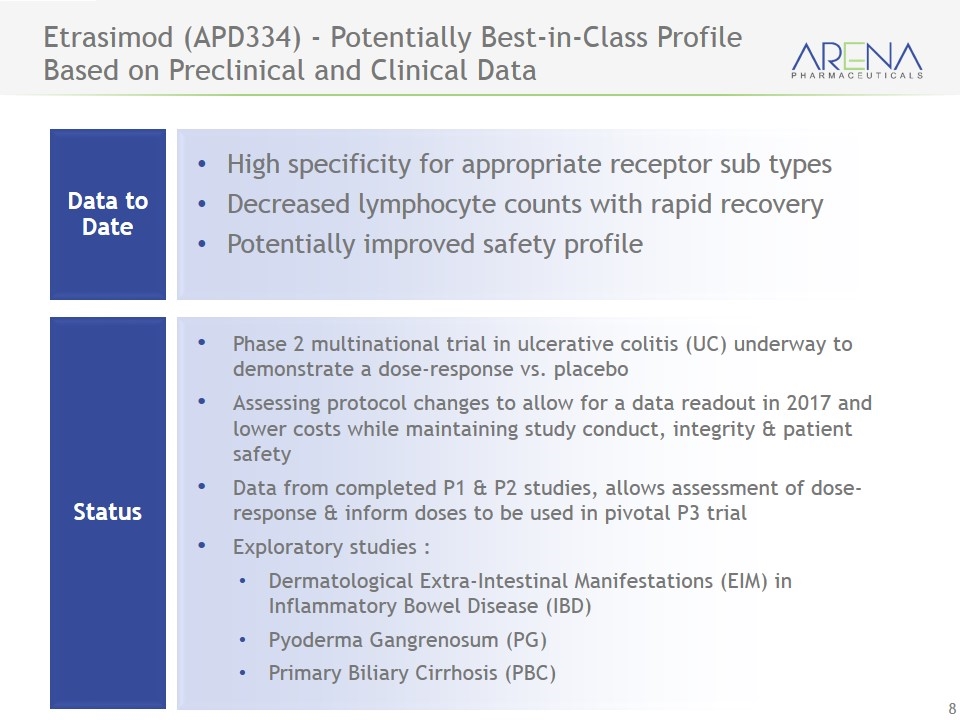
Etrasimod (APD334) - Potentially Best-in-Class Profile Based on Preclinical and Clinical Data Status High specificity for appropriate receptor sub types Decreased lymphocyte counts with rapid recovery Potentially improved safety profile Data to Date Phase 2 multinational trial in ulcerative colitis (UC) underway to demonstrate a dose-response vs. placebo Assessing protocol changes to allow for a data readout in 2017 and lower costs while maintaining study conduct, integrity & patient safety Data from completed P1 & P2 studies, allows assessment of dose-response & inform doses to be used in pivotal P3 trial Exploratory studies : Dermatological Extra-Intestinal Manifestations (EIM) in Inflammatory Bowel Disease (IBD) Pyoderma Gangrenosum (PG) Primary Biliary Cirrhosis (PBC)
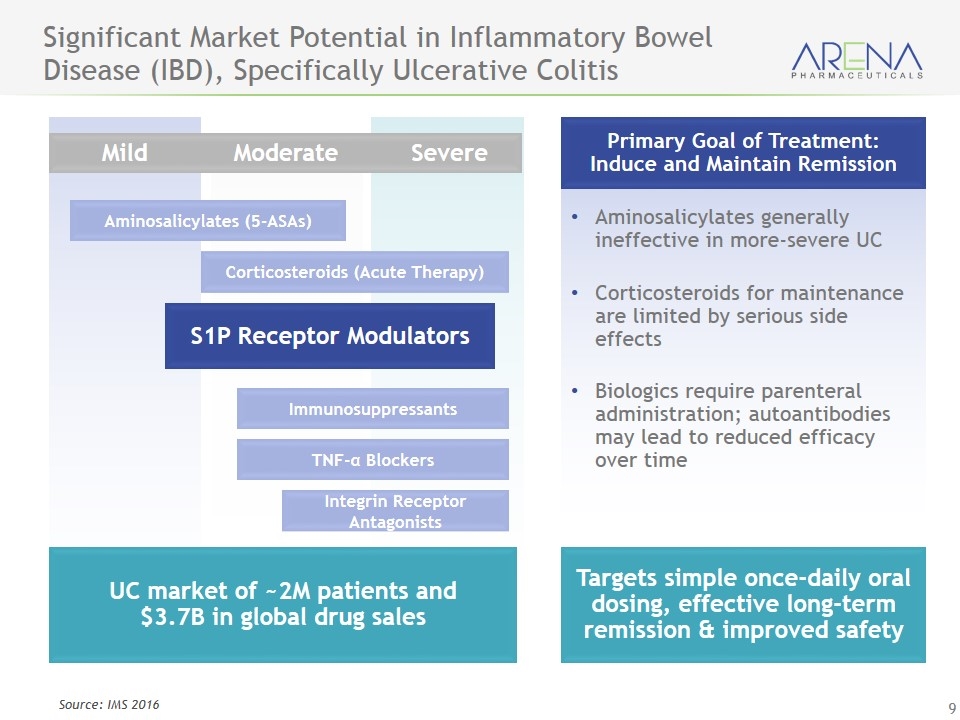
Aminosalicylates (5-ASAs) Corticosteroids (Acute Therapy) Immunosuppressants TNF-α Blockers Integrin Receptor Antagonists S1P Receptor Modulators Significant Market Potential in Inflammatory Bowel Disease (IBD), Specifically Ulcerative Colitis UC market of ~2M patients and $3.7B in global drug sales Primary Goal of Treatment: Induce and Maintain Remission Aminosalicylates generally ineffective in more-severe UC Corticosteroids for maintenance are limited by serious side effects Biologics require parenteral administration; autoantibodies may lead to reduced efficacy over time Targets simple once-daily oral dosing, effective long-term remission & improved safety Source: IMS 2016 Mild Moderate Severe
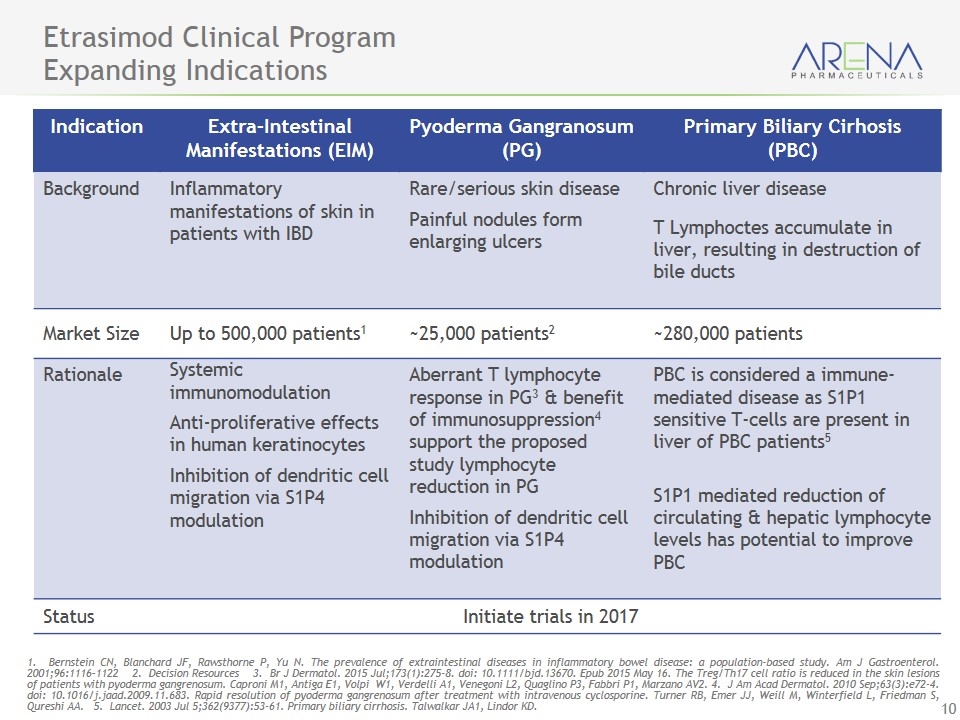
Etrasimod Clinical Program Expanding Indications 1. Bernstein CN, Blanchard JF, Rawsthorne P, Yu N. The prevalence of extraintestinal diseases in inflammatory bowel disease: a population-based study. Am J Gastroenterol. 2001;96:1116–1122 2. Decision Resources 3. Br J Dermatol. 2015 Jul;173(1):275-8. doi: 10.1111/bjd.13670. Epub 2015 May 16. The Treg/Th17 cell ratio is reduced in the skin lesions of patients with pyoderma gangrenosum. Caproni M1, Antiga E1, Volpi W1, Verdelli A1, Venegoni L2, Quaglino P3, Fabbri P1, Marzano AV2. 4. J Am Acad Dermatol. 2010 Sep;63(3):e72-4. doi: 10.1016/j.jaad.2009.11.683. Rapid resolution of pyoderma gangrenosum after treatment with intravenous cyclosporine. Turner RB, Emer JJ, Weill M, Winterfield L, Friedman S, Qureshi AA. 5. Lancet. 2003 Jul 5;362(9377):53-61. Primary biliary cirrhosis. Talwalkar JA1, Lindor KD. Indication Extra-Intestinal Manifestations (EIM) Pyoderma Gangranosum (PG) Primary Biliary Cirhosis (PBC) Background Inflammatory manifestations of skin in patients with IBD Rare/serious skin disease Painful nodules form enlarging ulcers Chronic liver disease T Lymphoctes accumulate in liver, resulting in destruction of bile ducts Market Size Up to 500,000 patients1 ~25,000 patients2 ~280,000 patients Rationale Systemic immunomodulation Anti-proliferative effects in human keratinocytes Inhibition of dendritic cell migration via S1P4 modulation Aberrant T lymphocyte response in PG3 & benefit of immunosuppression4 support the proposed study lymphocyte reduction in PG Inhibition of dendritic cell migration via S1P4 modulation PBC is considered a immune-mediated disease as S1P1 sensitive T-cells are present in liver of PBC patients5 S1P1 mediated reduction of circulating & hepatic lymphocyte levels has potential to improve PBC Status Initiate trials in 2017
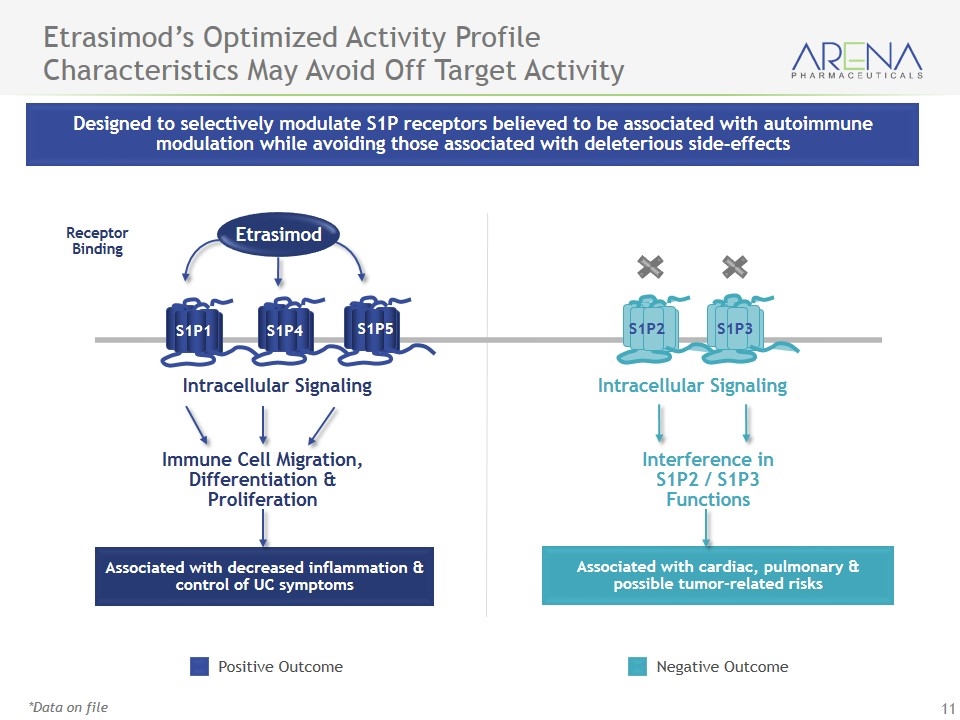
Designed to selectively modulate S1P receptors believed to be associated with autoimmune modulation while avoiding those associated with deleterious side-effects Etrasimod’s Optimized Activity Profile Characteristics May Avoid Off Target Activity *Data on file Associated with cardiac, pulmonary & possible tumor-related risks Associated with decreased inflammation & control of UC symptoms Immune Cell Migration, Differentiation & Proliferation Interference in S1P2 / S1P3 Functions Receptor Binding Intracellular Signaling Intracellular Signaling S1P2 S1P3 S1P1 S1P4 S1P5 Etrasimod Positive Outcome Negative Outcome
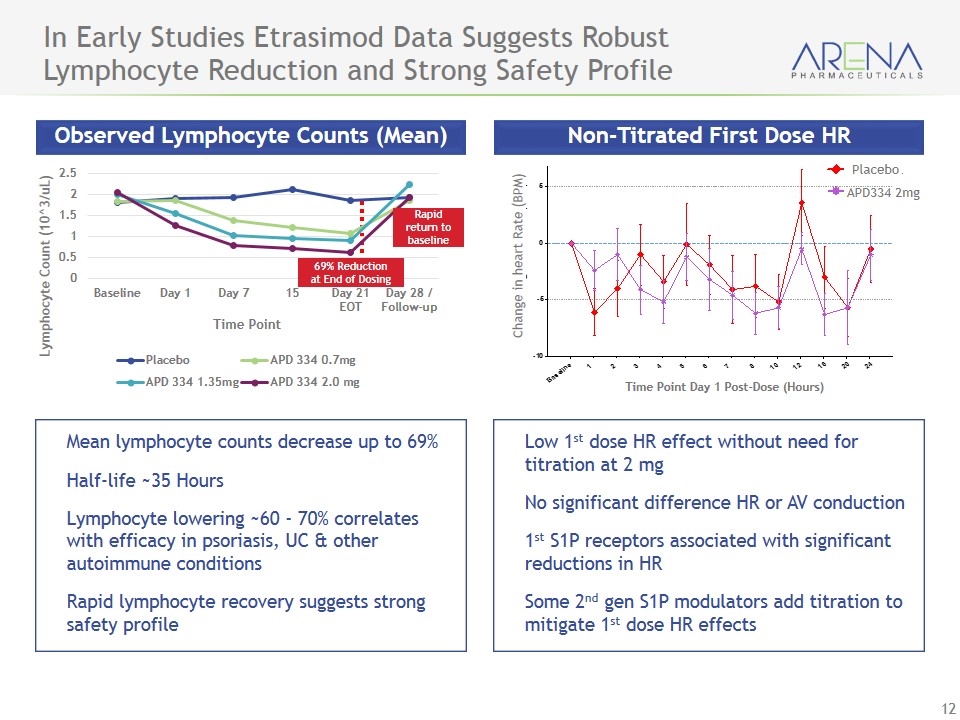
In Early Studies Etrasimod Data Suggests Robust Lymphocyte Reduction and Strong Safety Profile Observed Lymphocyte Counts (Mean) Non-Titrated First Dose HR Mean lymphocyte counts decrease up to 69% Half-life ~35 Hours Lymphocyte lowering ~60 - 70% correlates with efficacy in psoriasis, UC & other autoimmune conditions Rapid lymphocyte recovery suggests strong safety profile Low 1st dose HR effect without need for titration at 2 mg No significant difference HR or AV conduction 1st S1P receptors associated with significant reductions in HR Some 2nd gen S1P modulators add titration to mitigate 1st dose HR effects Rapid return to baseline 69% Reduction at End of Dosing Change in heart Rate (BPM) Placebo APD334 2mg Time Point Day 1 Post-Dose (Hours)

No symptomatic bradycardia No heart block (therapeutic dose) Based on Early Clinical Data Etrasimod Emerging as a Potential Best-in-Class S1P Modulator Excellent Lymphocyte Modulation 60-70% reduction in lymphocyte counts Recovery to baseline within one week Encouraging CV Safety Profile Clean Hepatotoxicity Safety Profile Favorable Pulmonary and Ocular Profile Promising PK and Adverse Event (AE) Profile Optimized Activity for the S1P Receptors No elevations in liver enzyme tests >1.3x in any dose group No clinically significant changes in pulmonary function tests No macular edema No titration; no discontinuations due to AEs No serious AEs; AEs not dose responsive No S1P2 internalization limits potential safety concerns
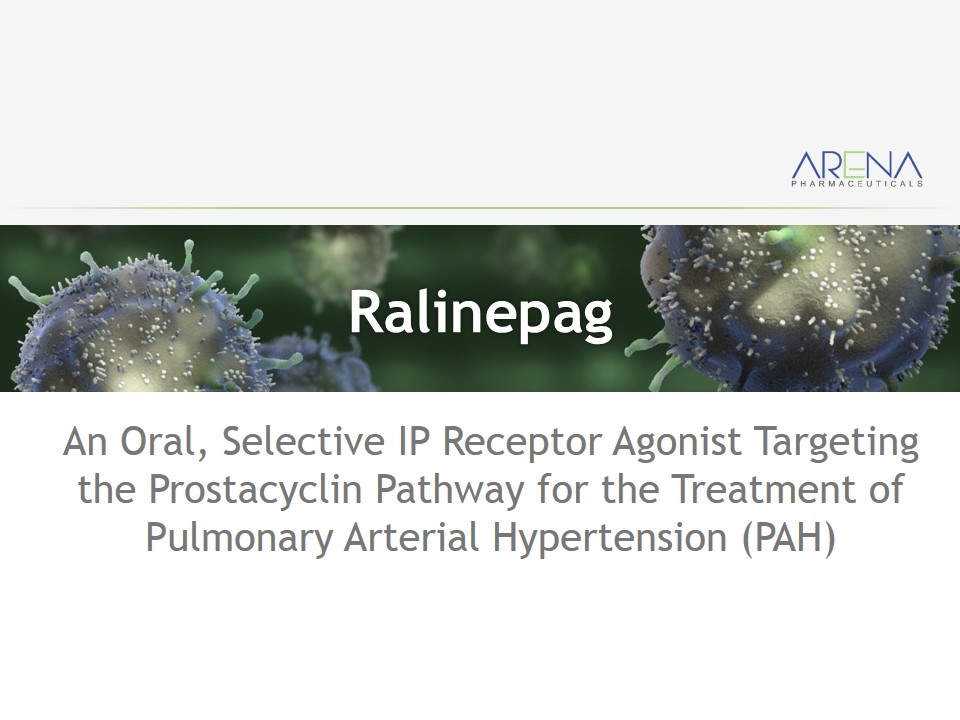
An Oral, Selective IP Receptor Agonist Targeting the Prostacyclin Pathway for the Treatment of Pulmonary Arterial Hypertension (PAH) Ralinepag
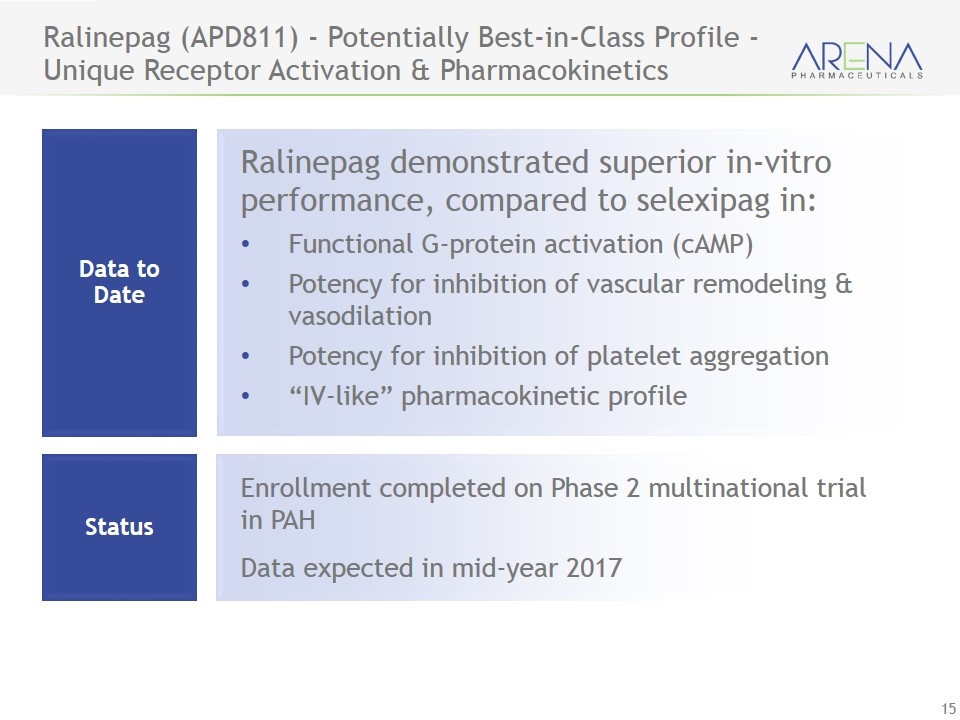
Ralinepag (APD811) - Potentially Best-in-Class Profile - Unique Receptor Activation & Pharmacokinetics Status Ralinepag demonstrated superior in-vitro performance, compared to selexipag in: Functional G-protein activation (cAMP) Potency for inhibition of vascular remodeling & vasodilation Potency for inhibition of platelet aggregation “IV-like” pharmacokinetic profile Data to Date Enrollment completed on Phase 2 multinational trial in PAH Data expected in mid-year 2017
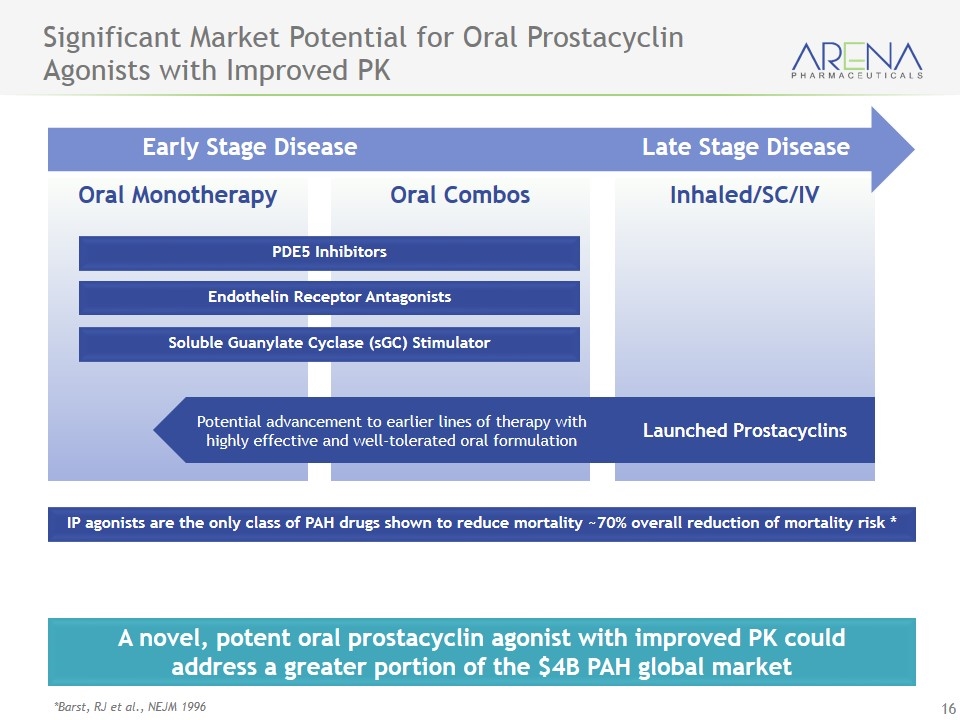
Oral Monotherapy Oral Combos Inhaled/SC/IV Significant Market Potential for Oral Prostacyclin Agonists with Improved PK A novel, potent oral prostacyclin agonist with improved PK could address a greater portion of the $4B PAH global market IP agonists are the only class of PAH drugs shown to reduce mortality ~70% overall reduction of mortality risk * *Barst, RJ et al., NEJM 1996 Early Stage Disease Late Stage Disease PDE5 Inhibitors Endothelin Receptor Antagonists Soluble Guanylate Cyclase (sGC) Stimulator Launched Prostacyclins Potential advancement to earlier lines of therapy with highly effective and well-tolerated oral formulation
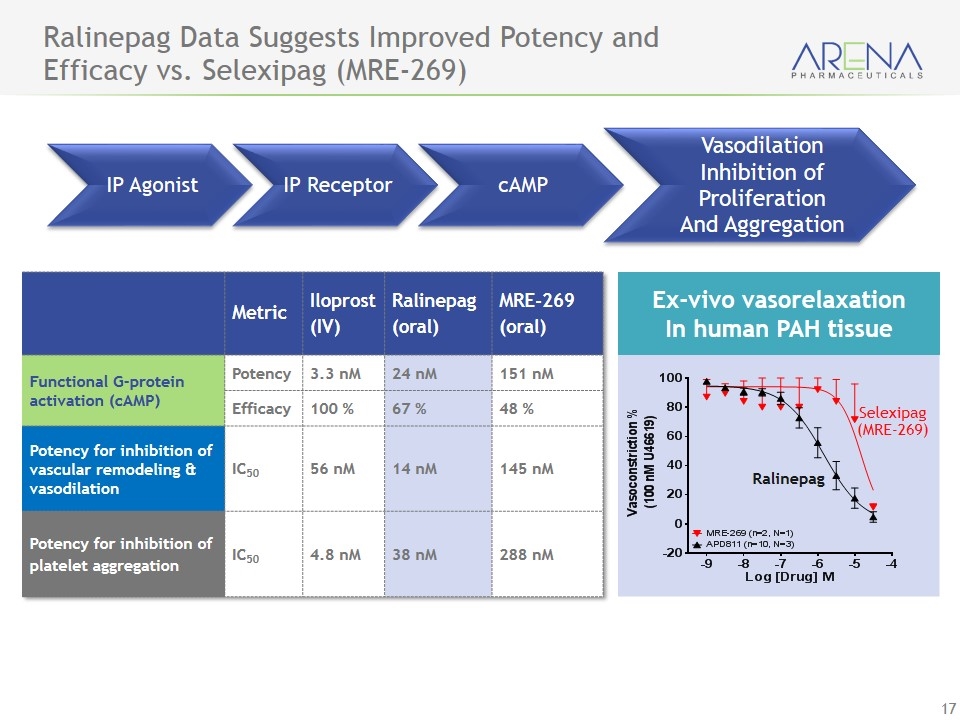
Ralinepag Data Suggests Improved Potency and Efficacy vs. Selexipag (MRE-269) Metric Iloprost (IV) Ralinepag (oral) MRE-269 (oral) Functional G-protein activation (cAMP) Potency 3.3 nM 24 nM 151 nM Efficacy 100 % 67 % 48 % Potency for inhibition of vascular remodeling & vasodilation IC50 56 nM 14 nM 145 nM Potency for inhibition of platelet aggregation IC50 4.8 nM 38 nM 288 nM Ex-vivo vasorelaxation In human PAH tissue Selexipag (MRE-269) Ralinepag IP Agonist cAMP Vasodilation Inhibition of Proliferation And Aggregation IP Receptor
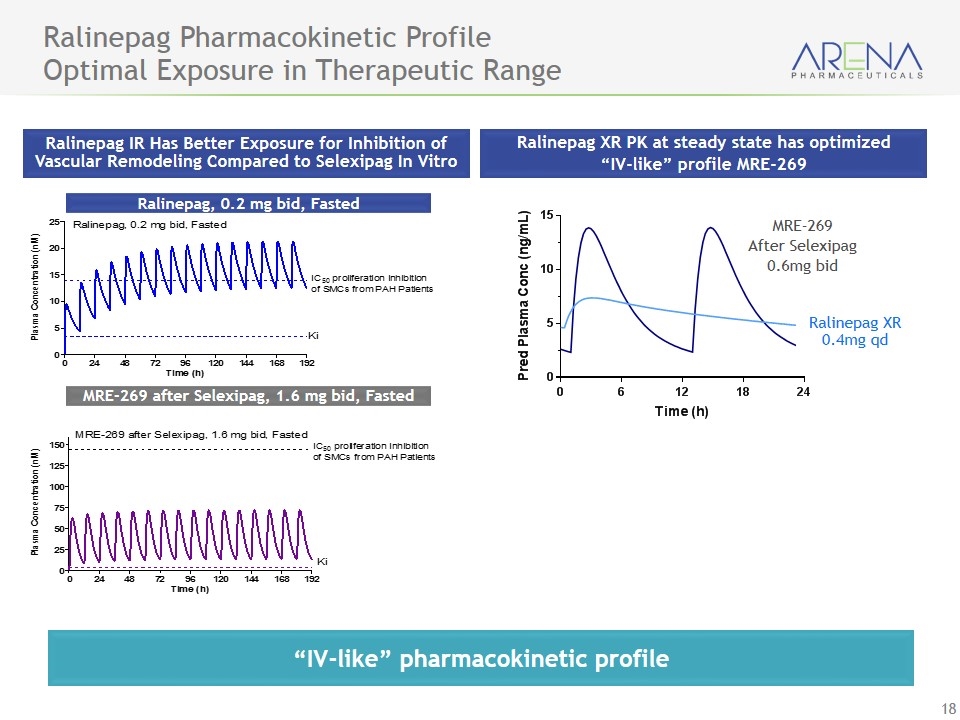
Ralinepag Pharmacokinetic Profile Optimal Exposure in Therapeutic Range Ralinepag IR Has Better Exposure for Inhibition of Vascular Remodeling Compared to Selexipag In Vitro MRE-269 after Selexipag, 1.6 mg bid, Fasted Ralinepag, 0.2 mg bid, Fasted Ralinepag XR PK at steady state has optimized “IV-like” profile MRE-269 MRE-269 After Selexipag 0.6mg bid “IV-like” pharmacokinetic profile Ralinepag XR 0.4mg qd
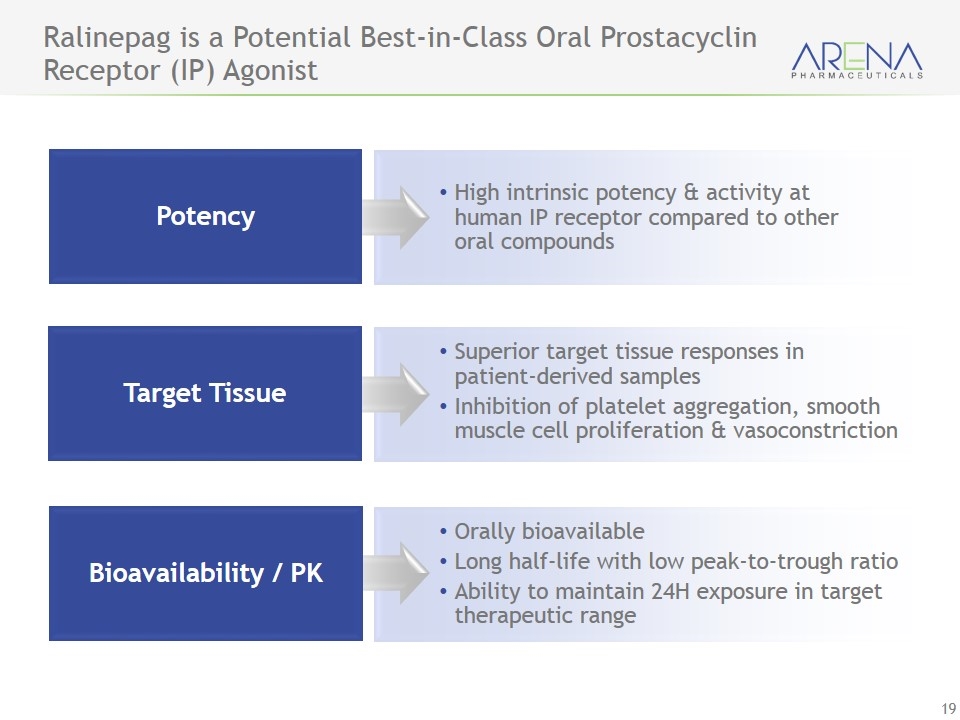
Ralinepag is a Potential Best-in-Class Oral Prostacyclin Receptor (IP) Agonist Potency High intrinsic potency & activity at human IP receptor compared to other oral compounds Superior target tissue responses in patient-derived samples Inhibition of platelet aggregation, smooth muscle cell proliferation & vasoconstriction Orally bioavailable Long half-life with low peak-to-trough ratio Ability to maintain 24H exposure in target therapeutic range Target Tissue Bioavailability / PK
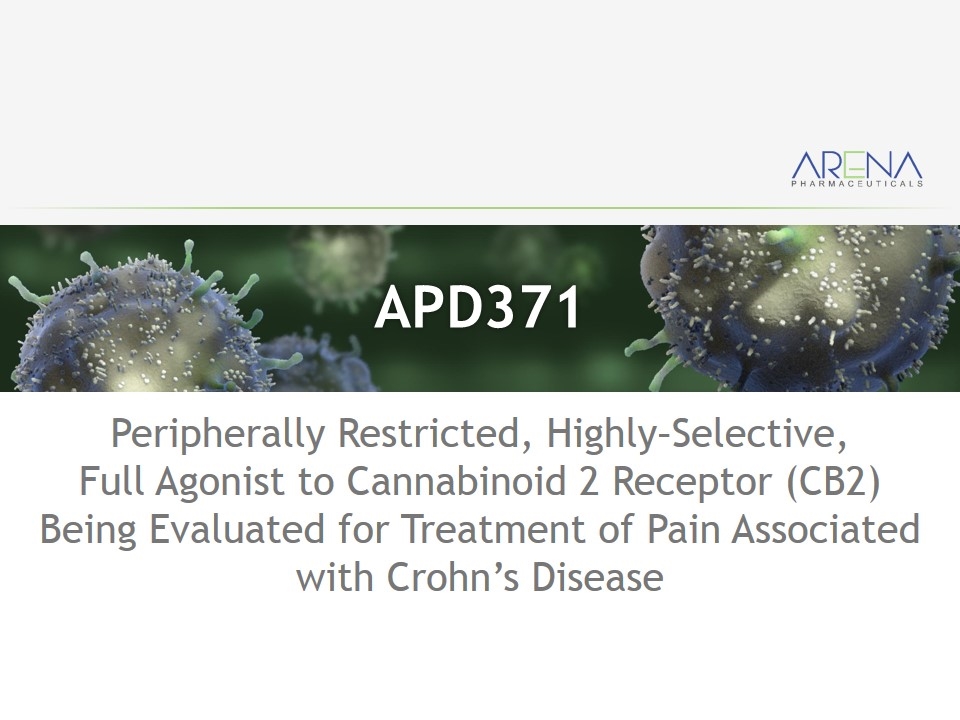
APD371 Peripherally Restricted, Highly–Selective, Full Agonist to Cannabinoid 2 Receptor (CB2) Being Evaluated for Treatment of Pain Associated with Crohn’s Disease
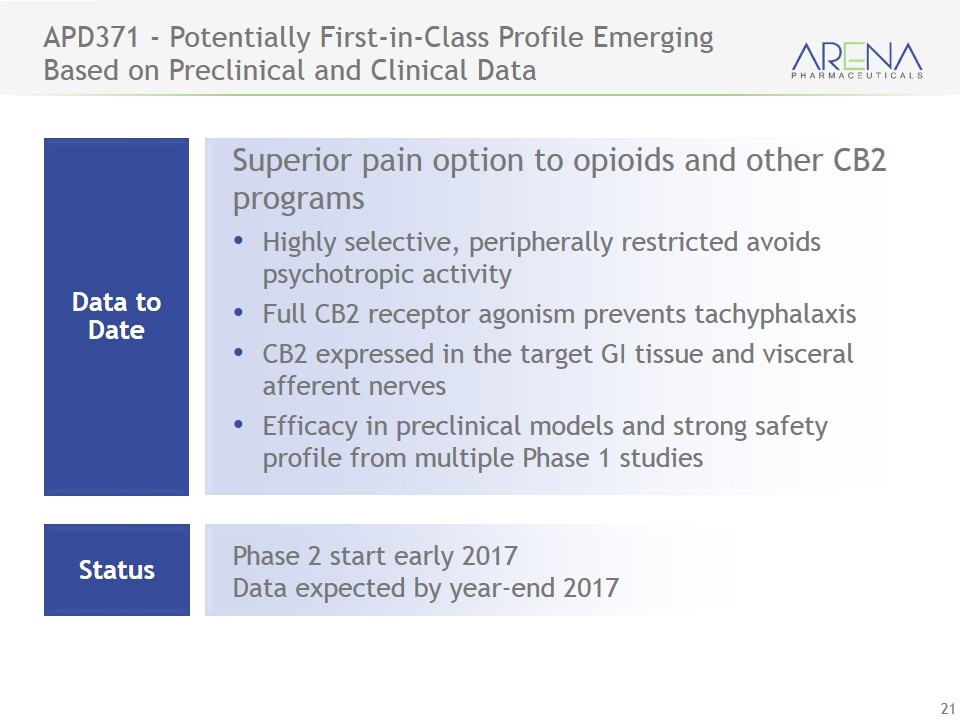
APD371 - Potentially First-in-Class Profile Emerging Based on Preclinical and Clinical Data Phase 2 start early 2017 Data expected by year-end 2017 Superior pain option to opioids and other CB2 programs Highly selective, peripherally restricted avoids psychotropic activity Full CB2 receptor agonism prevents tachyphalaxis CB2 expressed in the target GI tissue and visceral afferent nerves Efficacy in preclinical models and strong safety profile from multiple Phase 1 studies Data to Date Status
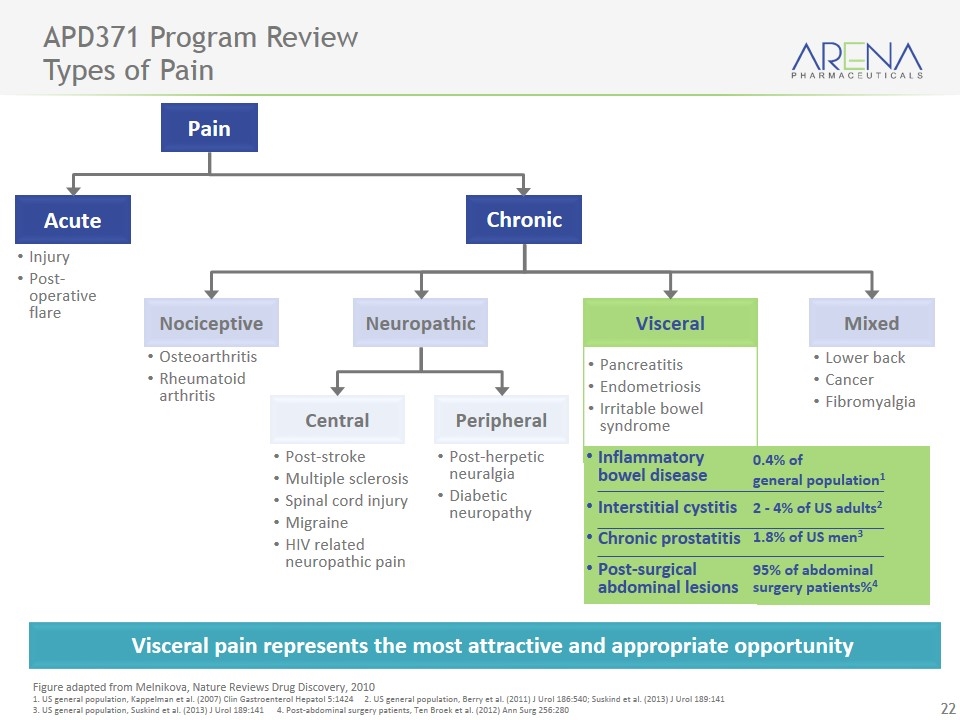
APD371 Program Review Types of Pain Visceral pain represents the most attractive and appropriate opportunity Figure adapted from Melnikova, Nature Reviews Drug Discovery, 2010 1. US general population, Kappelman et al. (2007) Clin Gastroenterol Hepatol 5:1424 2. US general population, Berry et al. (2011) J Urol 186:540; Suskind et al. (2013) J Urol 189:141 3. US general population, Suskind et al. (2013) J Urol 189:141 4. Post-abdominal surgery patients, Ten Broek et al. (2012) Ann Surg 256:280 Inflammatory bowel disease Interstitial cystitis Chronic prostatitis Post-surgical abdominal lesions Pain Acute Chronic Nociceptive Neuropathic Visceral Mixed Peripheral Central Lower back Cancer Fibromyalgia Post-herpetic neuralgia Diabetic neuropathy Post-stroke Multiple sclerosis Spinal cord injury Migraine HIV related neuropathic pain Osteoarthritis Rheumatoid arthritis Injury Post-operative flare 0.4% of general population1 2 - 4% of US adults2 95% of abdominal surgery patients%4 1.8% of US men3 Pancreatitis Endometriosis Irritable bowel syndrome
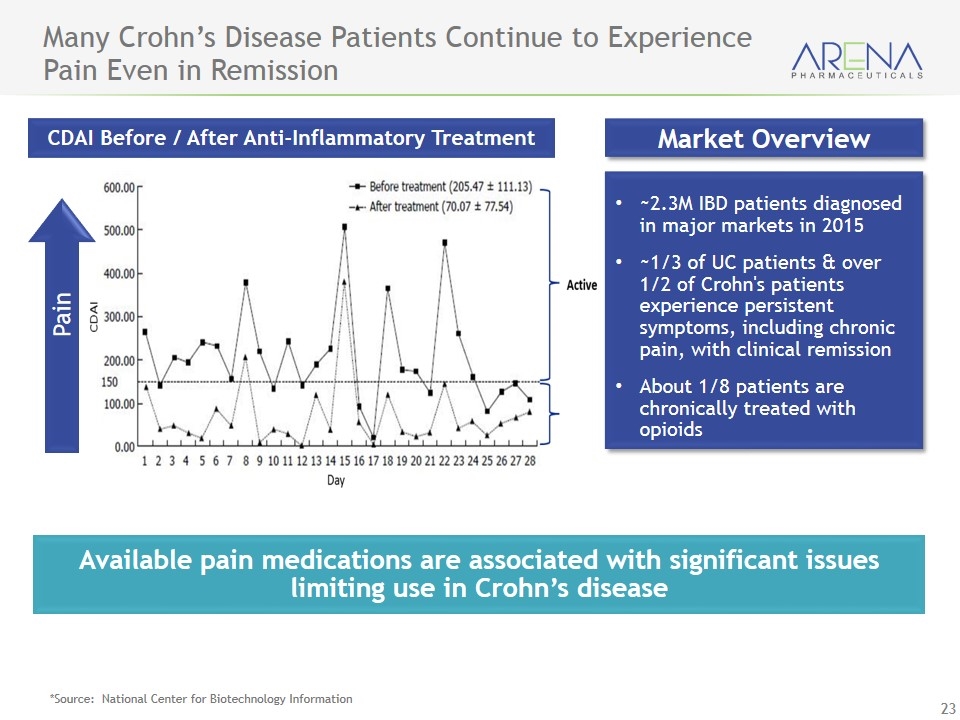
Many Crohn’s Disease Patients Continue to Experience Pain Even in Remission *Source: National Center for Biotechnology Information Available pain medications are associated with significant issues limiting use in Crohn’s disease Market Overview ~2.3M IBD patients diagnosed in major markets in 2015 ~1/3 of UC patients & over 1/2 of Crohn's patients experience persistent symptoms, including chronic pain, with clinical remission About 1/8 patients are chronically treated with opioids CDAI Before / After Anti-Inflammatory Treatment Pain
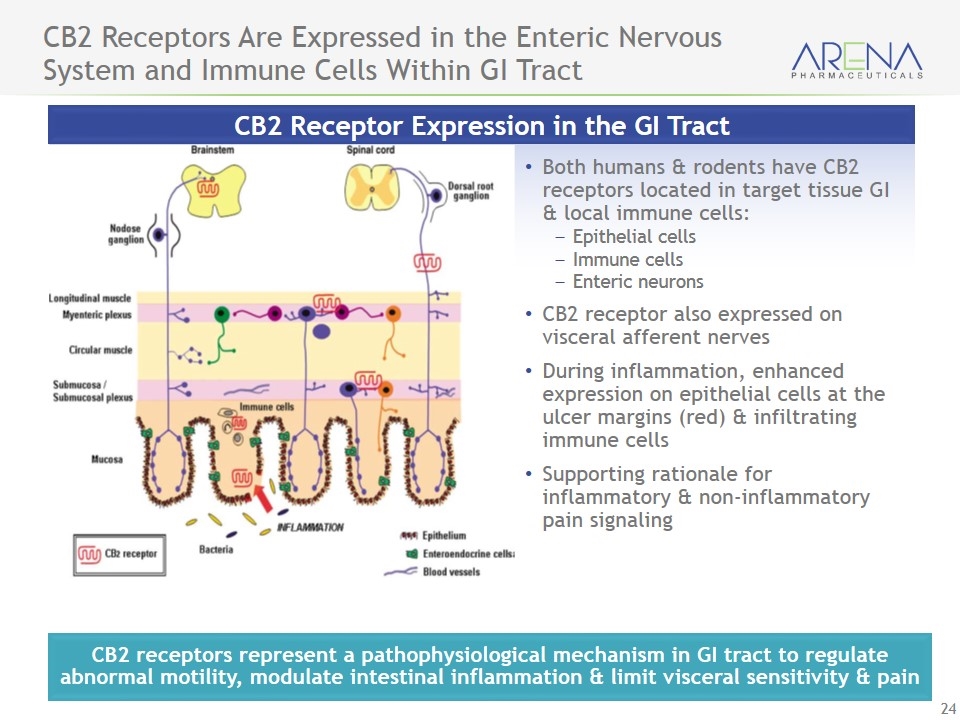
CB2 Receptors Are Expressed in the Enteric Nervous System and Immune Cells Within GI Tract Both humans & rodents have CB2 receptors located in target tissue GI & local immune cells: Epithelial cells Immune cells Enteric neurons CB2 receptor also expressed on visceral afferent nerves During inflammation, enhanced expression on epithelial cells at the ulcer margins (red) & infiltrating immune cells Supporting rationale for inflammatory & non-inflammatory pain signaling CB2 Receptor Expression in the GI Tract CB2 receptors represent a pathophysiological mechanism in GI tract to regulate abnormal motility, modulate intestinal inflammation & limit visceral sensitivity & pain
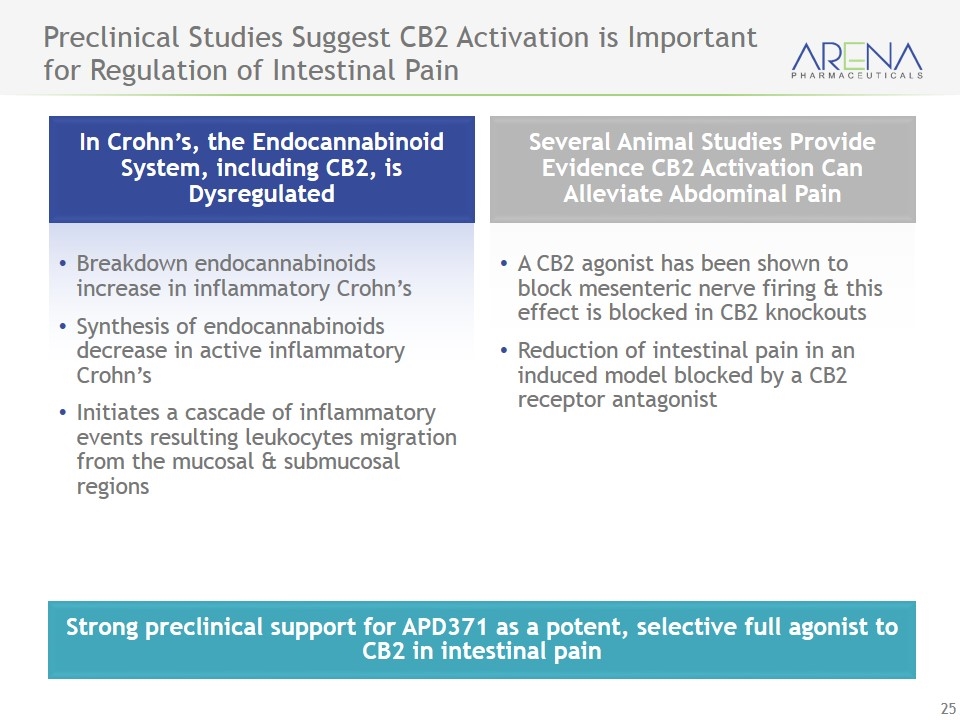
Strong preclinical support for APD371 as a potent, selective full agonist to CB2 in intestinal pain Preclinical Studies Suggest CB2 Activation is Important for Regulation of Intestinal Pain In Crohn’s, the Endocannabinoid System, including CB2, is Dysregulated Several Animal Studies Provide Evidence CB2 Activation Can Alleviate Abdominal Pain A CB2 agonist has been shown to block mesenteric nerve firing & this effect is blocked in CB2 knockouts Reduction of intestinal pain in an induced model blocked by a CB2 receptor antagonist Breakdown endocannabinoids increase in inflammatory Crohn’s Synthesis of endocannabinoids decrease in active inflammatory Crohn’s Initiates a cascade of inflammatory events resulting leukocytes migration from the mucosal & submucosal regions
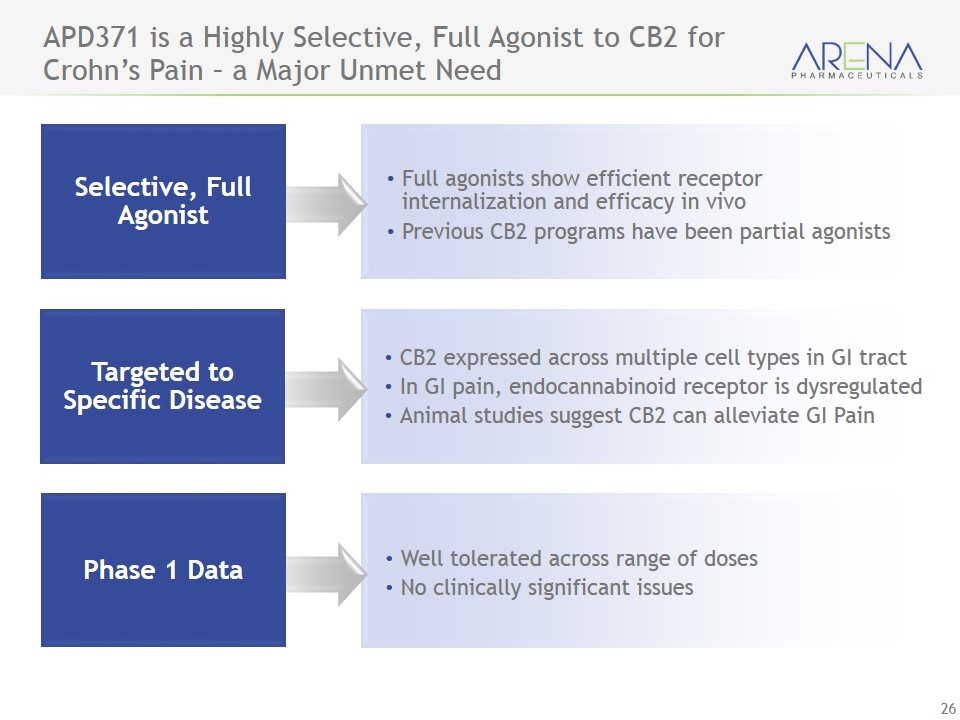
APD371 is a Highly Selective, Full Agonist to CB2 for Crohn’s Pain – a Major Unmet Need Selective, Full Agonist Full agonists show efficient receptor internalization and efficacy in vivo Previous CB2 programs have been partial agonists CB2 expressed across multiple cell types in GI tract In GI pain, endocannabinoid receptor is dysregulated Animal studies suggest CB2 can alleviate GI Pain Well tolerated across range of doses No clinically significant issues Targeted to Specific Disease Phase 1 Data
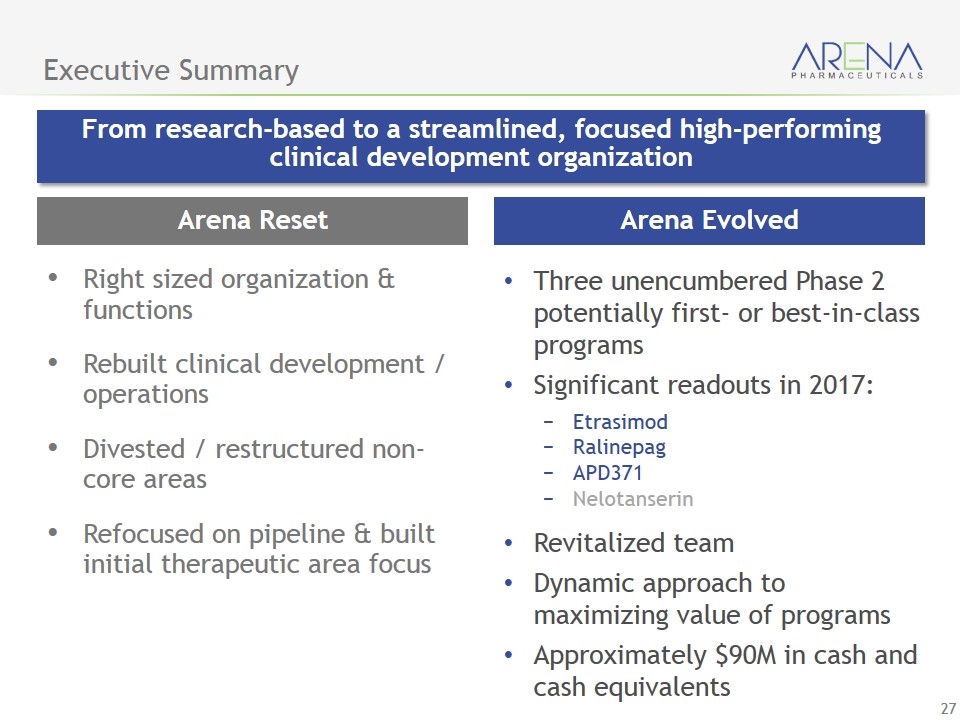
Arena Evolved Executive Summary From research-based to a streamlined, focused high-performing clinical development organization Three unencumbered Phase 2 potentially first- or best-in-class programs Significant readouts in 2017: Etrasimod Ralinepag APD371 Nelotanserin Revitalized team Dynamic approach to maximizing value of programs Approximately $90M in cash and cash equivalents Arena Reset Right sized organization & functions Rebuilt clinical development / operations Divested / restructured non-core areas Refocused on pipeline & built initial therapeutic area focus

NASDAQ: ARNA Thank you



























